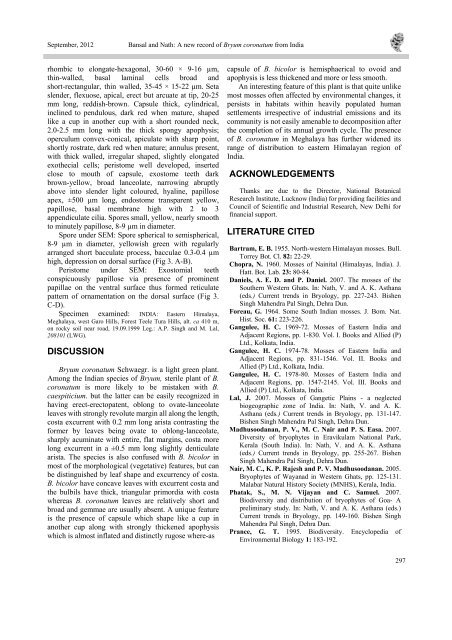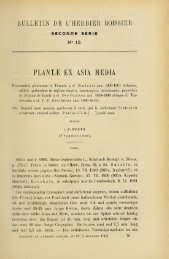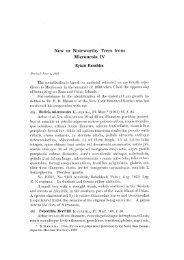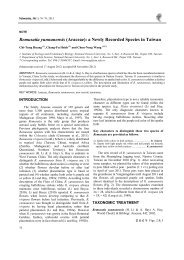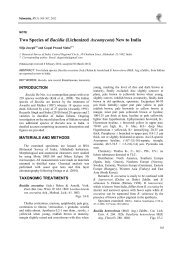A New Record of Bryum coronatum Schwaegr. (Bryophyte) in ...
A New Record of Bryum coronatum Schwaegr. (Bryophyte) in ...
A New Record of Bryum coronatum Schwaegr. (Bryophyte) in ...
Create successful ePaper yourself
Turn your PDF publications into a flip-book with our unique Google optimized e-Paper software.
September, 2012 Bansal and Nath: A new record <strong>of</strong> <strong>Bryum</strong> <strong>coronatum</strong> from India<br />
rhombic to elongate-hexagonal, 30-60 × 9-16 µm,<br />
th<strong>in</strong>-walled, basal lam<strong>in</strong>al cells broad and<br />
short-rectangular, th<strong>in</strong> walled, 35-45 × 15-22 µm. Seta<br />
slender, flexuose, apical, erect but arcuate at tip, 20-25<br />
mm long, reddish-brown. Capsule thick, cyl<strong>in</strong>drical,<br />
<strong>in</strong>cl<strong>in</strong>ed to pendulous, dark red when mature, shaped<br />
like a cup <strong>in</strong> another cup with a short rounded neck,<br />
2.0-2.5 mm long with the thick spongy apophysis;<br />
operculum convex-conical, apiculate with sharp po<strong>in</strong>t,<br />
shortly rostrate, dark red when mature; annulus present,<br />
with thick walled, irregular shaped, slightly elongated<br />
exothecial cells; peristome well developed, <strong>in</strong>serted<br />
close to mouth <strong>of</strong> capsule, exostome teeth dark<br />
brown-yellow, broad lanceolate, narrow<strong>in</strong>g abruptly<br />
above <strong>in</strong>to slender light coloured, hyal<strong>in</strong>e, papillose<br />
apex, ±500 µm long, endostome transparent yellow,<br />
papillose, basal membrane high with 2 to 3<br />
appendiculate cilia. Spores small, yellow, nearly smooth<br />
to m<strong>in</strong>utely papillose, 8-9 µm <strong>in</strong> diameter.<br />
Spore under SEM: Spore spherical to semispherical,<br />
8-9 µm <strong>in</strong> diameter, yellowish green with regularly<br />
arranged short bacculate process, bacculae 0.3-0.4 µm<br />
high, depression on dorsal surface (Fig 3. A-B).<br />
Peristome under SEM: Exostomial teeth<br />
conspicuously papillose via presence <strong>of</strong> prom<strong>in</strong>ent<br />
papillae on the ventral surface thus formed reticulate<br />
pattern <strong>of</strong> ornamentation on the dorsal surface (Fig 3.<br />
C-D).<br />
Specimen exam<strong>in</strong>ed: INDIA: Eastern Himalaya,<br />
Meghalaya, west Garo Hills, Forest Teele Tura Hills, alt. ca 410 m,<br />
on rocky soil near road, 19.09.1999 Leg.: A.P. S<strong>in</strong>gh and M. Lal,<br />
208101 (LWG).<br />
DISCUSSION<br />
<strong>Bryum</strong> <strong>coronatum</strong> <strong>Schwaegr</strong>. is a light green plant.<br />
Among the Indian species <strong>of</strong> <strong>Bryum</strong>, sterile plant <strong>of</strong> B.<br />
<strong>coronatum</strong> is more likely to be mistaken with B.<br />
caespiticium. but the latter can be easily recognized <strong>in</strong><br />
hav<strong>in</strong>g erect-erectopatent, oblong to ovate-lanceolate<br />
leaves with strongly revolute marg<strong>in</strong> all along the length,<br />
costa excurrent with 0.2 mm long arista contrast<strong>in</strong>g the<br />
former by leaves be<strong>in</strong>g ovate to oblong-lanceolate,<br />
sharply acum<strong>in</strong>ate with entire, flat marg<strong>in</strong>s, costa more<br />
long excurrent <strong>in</strong> a ±0.5 mm long slightly denticulate<br />
arista. The species is also confused with B. bicolor <strong>in</strong><br />
most <strong>of</strong> the morphological (vegetative) features, but can<br />
be dist<strong>in</strong>guished by leaf shape and excurrency <strong>of</strong> costa.<br />
B. bicolor have concave leaves with excurrent costa and<br />
the bulbils have thick, triangular primordia with costa<br />
whereas B. <strong>coronatum</strong> leaves are relatively short and<br />
broad and gemmae are usually absent. A unique feature<br />
is the presence <strong>of</strong> capsule which shape like a cup <strong>in</strong><br />
another cup along with strongly thickened apophysis<br />
which is almost <strong>in</strong>flated and dist<strong>in</strong>ctly rugose where-as<br />
capsule <strong>of</strong> B. bicolor is hemisphaerical to ovoid and<br />
apophysis is less thickened and more or less smooth.<br />
An <strong>in</strong>terest<strong>in</strong>g feature <strong>of</strong> this plant is that quite unlike<br />
most mosses <strong>of</strong>ten affected by environmental changes, it<br />
persists <strong>in</strong> habitats with<strong>in</strong> heavily populated human<br />
settlements irrespective <strong>of</strong> <strong>in</strong>dustrial emissions and its<br />
community is not easily amenable to decomposition after<br />
the completion <strong>of</strong> its annual growth cycle. The presence<br />
<strong>of</strong> B. <strong>coronatum</strong> <strong>in</strong> Meghalaya has further widened its<br />
range <strong>of</strong> distribution to eastern Himalayan region <strong>of</strong><br />
India.<br />
ACKNOWLEDGEMENTS<br />
Thanks are due to the Director, National Botanical<br />
Research Institute, Lucknow (India) for provid<strong>in</strong>g facilities and<br />
Council <strong>of</strong> Scientific and Industrial Research, <strong>New</strong> Delhi for<br />
f<strong>in</strong>ancial support.<br />
LITERATURE CITED<br />
Bartram, E. B. 1955. North-western Himalayan mosses. Bull.<br />
Torrey Bot. Cl. 82: 22-29.<br />
Chopra, N. 1960. Mosses <strong>of</strong> Na<strong>in</strong>ital (Himalayas, India). J.<br />
Hatt. Bot. Lab. 23: 80-84.<br />
Daniels, A. E. D. and P. Daniel. 2007. The mosses <strong>of</strong> the<br />
Southern Western Ghats. In: Nath, V. and A. K. Asthana<br />
(eds.) Current trends <strong>in</strong> Bryology, pp. 227-243. Bishen<br />
S<strong>in</strong>gh Mahendra Pal S<strong>in</strong>gh, Dehra Dun.<br />
Foreau, G. 1964. Some South Indian mosses. J. Bom. Nat.<br />
Hist. Soc. 61: 223-226.<br />
Gangulee, H. C. 1969-72. Mosses <strong>of</strong> Eastern India and<br />
Adjacent Regions, pp. 1-830. Vol. I. Books and Allied (P)<br />
Ltd., Kolkata, India.<br />
Gangulee, H. C. 1974-78. Mosses <strong>of</strong> Eastern India and<br />
Adjacent Regions, pp. 831-1546. Vol. II. Books and<br />
Allied (P) Ltd., Kolkata, India.<br />
Gangulee, H. C. 1978-80. Mosses <strong>of</strong> Eastern India and<br />
Adjacent Regions, pp. 1547-2145. Vol. III. Books and<br />
Allied (P) Ltd., Kolkata, India.<br />
Lal, J. 2007. Mosses <strong>of</strong> Gangetic Pla<strong>in</strong>s - a neglected<br />
biogeographic zone <strong>of</strong> India. In: Nath, V. and A. K.<br />
Asthana (eds.) Current trends <strong>in</strong> Bryology, pp. 131-147.<br />
Bishen S<strong>in</strong>gh Mahendra Pal S<strong>in</strong>gh, Dehra Dun.<br />
Madhusoodanan, P. V., M. C. Nair and P. S. Easa. 2007.<br />
Diversity <strong>of</strong> bryophytes <strong>in</strong> Eravikulam National Park,<br />
Kerala (South India). In: Nath, V. and A. K. Asthana<br />
(eds.) Current trends <strong>in</strong> Bryology, pp. 255-267. Bishen<br />
S<strong>in</strong>gh Mahendra Pal S<strong>in</strong>gh, Dehra Dun.<br />
Nair, M. C., K. P. Rajesh and P. V. Madhusoodanan. 2005.<br />
<strong>Bryophyte</strong>s <strong>of</strong> Wayanad <strong>in</strong> Western Ghats, pp. 125-131.<br />
Malabar Natural History Society (MNHS), Kerala, India.<br />
Phatak, S., M. N. Vijayan and C. Samuel. 2007.<br />
Biodiversity and distribution <strong>of</strong> bryophytes <strong>of</strong> Goa- A<br />
prelim<strong>in</strong>ary study. In: Nath, V. and A. K. Asthana (eds.)<br />
Current trends <strong>in</strong> Bryology, pp. 149-160. Bishen S<strong>in</strong>gh<br />
Mahendra Pal S<strong>in</strong>gh, Dehra Dun.<br />
Prance, G. T. 1995. Biodiversity. Encyclopedia <strong>of</strong><br />
Environmental Biology 1: 183-192.<br />
297


